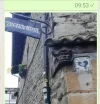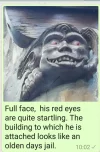While in Pamplona (September 2018)I did a bit of sightseeing. Just past the Catedral Santa Maria, there's a park with benches, fountains etc. Just beyond the park I came across a short lane and this image. Anyone know what this figure and the writing mean?
-
Remove ads on the forum by becoming a donating member. More here.
Search 74,075 Camino Questions
You are using an out of date browser. It may not display this or other websites correctly.
You should upgrade or use an alternative browser.
You should upgrade or use an alternative browser.
Strange figures.
- Thread starter Travelite
- Start date
Perfect memento/gift in a presentation box. Engraving available, 25 character max.
Stephen Nicholls
Steve Nicholls, Suffolk, U.K.
- Time of past OR future Camino
- Too many caminos to list in the permitted 100 characters!!
They are amazing gargoyles. We have them on many medieval churches in England. But I have no idea why they should be on that building - unless it was once a church?
- Time of past OR future Camino
- Too many and too often!
Apparently Zugarrondoa is the Basque name for the elm tree. There used to be a famous one in the area and it gave the name to the plaza and the surrounding district. The little plaque on the wall says "Euskal Herria" which is a very old term for the Basque Country. The swastika-like symbol on it is a traditional symbol in Basque art representing the region and is called the lauburu: https://en.wikipedia.org/wiki/Lauburu No idea why the wooden grotesque is there but he is very photogenic 
Train for your next Camino on California's Santa Catalina Island March 16-19
SYates
Camino Fossil AD 1999, now living in Santiago de C
- Time of past OR future Camino
- First: Camino Francés 1999
...
Last: Santiago - Muxia 2019
Now: http://egeria.house/
Might they be the Basque equivalent of the Green Man https://en.wikipedia.org/wiki/Green_Man - just thinking out loud here ...
BC SY
BC SY
- Time of past OR future Camino
- To Santiago and back. Le Puy to Aumont-Aubrac.
I think that the wooden sculpture is modern. The house is in a picturesque street on the way to the Caballo Blanco restaurant. I am sure that I walked through this street. Below are some images, the second one shows the house before the sculpture and other items were added. The house was renovated in 2012. The sculpture is perhaps inspired by the grotesque faces one can see on Romanesque capitals and corbels or in fact by Gothic gargoyles as already mentioned. It looks like a dragon with wings. Basque mythology? Definitely a very Basque house. Intriguing.
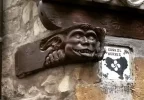
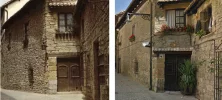


Last edited:
- Time of past OR future Camino
- To Santiago and back. Le Puy to Aumont-Aubrac.
The plant that is fixed on the wall above the door of the house is a dried silver thistle and part of Basque culture and traditions. It was said to ward off evil spirits during the night. Supposedly because it resembles the sun and makes the evil spirits believe that it is daylight instead of night.
Here's another one. The Basque name is eguzkilore. Nailing it to one's door became apparently fashionable again in recent time. Another potent symbol of Basque identity.
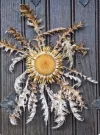
Here's another one. The Basque name is eguzkilore. Nailing it to one's door became apparently fashionable again in recent time. Another potent symbol of Basque identity.

Last edited:
The 2024 Camino guides will be coming out little by little. Here is a collection of the ones that are out so far.
Thank you one and all for the explanations. Much appreciated.Might they be the Basque equivalent of the Green Man https://en.wikipedia.org/wiki/Green_Man - just thinking out loud here ...
BC SY
Really did not look like a church building to me. The building has a small barred window too, and my first thought was, Aha, an old-time jail?They are amazing gargoyles. We have them on many medieval churches in England. But I have no idea why they should be on that building - unless it was once a church?
- Time of past OR future Camino
- To Santiago and back. Le Puy to Aumont-Aubrac.
These iron bars in front of a ground floor window or door say Spain to me, not jailThe building has a small barred window too, and my first thought was, Aha, an old-time jail?
Perfect memento/gift in a presentation box. Engraving available, 25 character max.
- Time of past OR future Camino
- To Santiago and back. Le Puy to Aumont-Aubrac.
Maybe the wooden sculpture is not a dragon with wings but a lion with a tail in reference to the coat of arms of Pamplona city - you can spot this symbol quite a few times in Pamplona; the same lion appears also in the coat of arms of Euskal Herria (Greater Basque Country). That would perhaps make sense. There are also symbols carved into the wooden door lintels, one of them is a fleur de lys and another one has the shape of an eagle as used in heraldry.It looks like a dragon with wings.
Last edited:
Not a gargoyleThey are amazing gargoyles. We have them on many medieval churches in England. But I have no idea why they should be on that building - unless it was once a church?
D
Deleted member 73526
Guest
Perfect memento/gift in a presentation box. Engraving available, 25 character max.
- Time of past OR future Camino
- Recent:Norte/Muxia- Spring '23
MadridWay- Fall '23
Apparently the superstition of using thistles is not limited to Basque culture. I snapped this picture on the Le Puy route in Saint Come D'Olt last June.The plant that is fixed on the wall above the door of the house is a dried silver thistle and part of Basque culture and traditions. It was said to ward off evil spirits during the night. Supposedly because it resembles the sun and makes the evil spirits believe that it is daylight instead of night.
Here's another one. The Basque name is eguzkilore. Nailing it to one's door became apparently fashionable again in recent time. Another potent symbol of Basque identity.
View attachment 49696
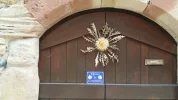
- Time of past OR future Camino
- To Santiago and back. Le Puy to Aumont-Aubrac.
Looking at the carvings on the lintel above the two doors and at a coat of arms in the Pamplona town hall make me think that all these elements on the house, including the wooden sculpture, are modern references to the history of Pamplona and Navarra. But unless someone rings the bell and asks we will probably never know. Anyone? It's very close to the cathedral.There are also symbols carved into the wooden door lintels, one of them is a fleur de lys and another one has the shape of an eagle as used in heraldry.

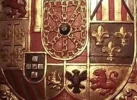
Last edited:
Yes, you probably did. The street is the same one I walked from what I recall. . But there were so many tourists just after this sculpture that I walked back the way I'd come.I think that the wooden sculpture is modern. The house is in a picturesque street on the way to the Caballo Blanco restaurant. I am sure that I walked through this street. Below are some images, the second one shows the house before the sculpture and other items were added. The house was renovated in 2012. The sculpture is perhaps inspired by the grotesque faces one can see on Romanesque capitals and corbels or in fact by Gothic gargoyles as already mentioned. It looks like a dragon with wings. Basque mythology? Definitely a very Basque house. Intriguing.
View attachment 49682
View attachment 49728
A selection of Camino Jewellery
OH? I saw bars and thought, perhaps a prison? Thanks for the explanation. I had asked Pilgrims about it and not answer was forthcoming. Even the manager of the Albergue where I stayed did not know. So thanks for putting me straight.These iron bars in front of a ground floor window or door say Spain to me, not jail. I think they serve to keep people and dogs out - not in - when the window or door is open.
- Time of past OR future Camino
- To Santiago and back. Le Puy to Aumont-Aubrac.
I could not find anything about the house in this well known and often photographed street that would indicate that it was once a prison. It looks like a typical Basque house to me. Below is a Wikipedia photo of a typical Basque farmhouse. Here, too, you can see iron bars in front of the two ground floor windows.I had asked Pilgrims about it and no answer was forthcoming. Even the manager of the Albergue where I stayed did not know.
The Pamplona house reminded me of the hotel in Akerreta just after Larrasoaña; it's a beautifully restored old farmhouse. The owner told us that the ground floor which now houses the reception and the restaurant etc used to be the stables or barn, ie it had the traditional layout of such houses. The house in Pamplona may have had a similar arrangement, ie the ground floor was not used as living quarters.
@Travelite, you post interesting questions
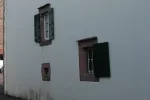
Last edited:
❓How to ask a question
How to post a new question on the Camino Forum.
Most read last week in this forum
I saw a video with a rather harsh criticism of a small, municipal albergue on one of the less traveled caminos. They paid 9€. I thought: What does it cost a small municipality to renovate and keep...
On my last Camino (2023) I noticed that there were lots of tourists. It reminded me of a couple of quotes that I have read since my first Camino (2015)
“A tourist demands, a pilgrim is grateful”...
"A complete guide to the world's greatest pilgrimage"[sic] by Sarah Baxter.
In a British newspaper, The Telegraph. A right wing daily that does print interesting articles and essays...
I've been trying to figure out how to use the Gronze app and as a first step I need to translate into English - I searched topics on the Forum, thought I found what I was looking for, and Yay! I...
I was hoping to do a walk over ninety days so I researched a long stay visa. This walk would have gone through four countries but the majority of the time would have been in France. So I applied...
Similar threads
- Replies
- 13
- Views
- 2K
- Replies
- 12
- Views
- 1K
LIVE from the Camino
Here we goooo!
- Replies
- 104
- Views
- 8K
❓How to ask a question
How to post a new question on the Camino Forum.
Latest posts
-
-
The Camino and maybe not quite 'getting it'?
- Latest: Juspassinthru
Most downloaded Resources
-
“All” Albergues on the Camino Frances in one pdf“All” Albergues on the Camino Frances in one pdf
- ivar
- Updated:
-
A selection of favorite albergues on the Camino FrancésFavorite Albergues along the Camino Frances
- Ton van Tilburg
- Updated:
-
Profile maps of all 34 stages of the Camino FrancesProfile maps of all 34 stages of the Camino Frances
- ivar
- Updated:


